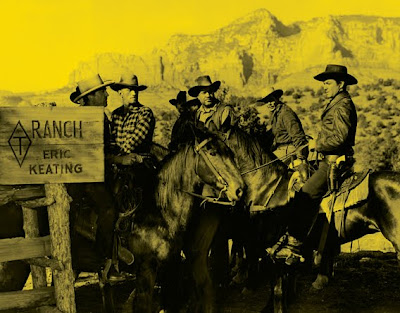
Billy The Kid was a wanted man in 1930s-’40s Hollywood. After the release of MGM’s big budget Billy the Kid in 1930 (directed by King Vidor and starring Johnny Mack Brown), the character made a brief reappearance (played by uncredited Lynton Brent) in Tom Mix’s The Texas Bad Man, released by Universal Pictures in 1932. The desperado laid low before resurfacing in Republic’s Billy the Kid Returns (1938), this time as half of a dual role played by “king of the cowboys” Roy Rogers in his second starring film.
 Two years later, ultralow-budget Producers Releasing Corp. (PRC) initiated a Saturday matinee series with Billy the Kid Outlawed (1940), which rewrote history by changing The Kid from horse-thieving gunman to benevolent Stetsoned Robin Hood. “B’’-movie cowboy Bob Steele played him in the first six films, released during the 1940-’41 season. Steele was replaced by former Flash Gordon/Buck Rogers/Tarzan star Buster Crabbe, who headlined thirteen more PRC Billy the Kid cheapies between 1941 and 1943. In these, the real-life character’s name (or alias) Billy Bonney was changed to Billy Carson, reportedly because of complaints that the films glorified a notorious criminal. Crabbe continued with the series for twenty-three more films into 1946.
Two years later, ultralow-budget Producers Releasing Corp. (PRC) initiated a Saturday matinee series with Billy the Kid Outlawed (1940), which rewrote history by changing The Kid from horse-thieving gunman to benevolent Stetsoned Robin Hood. “B’’-movie cowboy Bob Steele played him in the first six films, released during the 1940-’41 season. Steele was replaced by former Flash Gordon/Buck Rogers/Tarzan star Buster Crabbe, who headlined thirteen more PRC Billy the Kid cheapies between 1941 and 1943. In these, the real-life character’s name (or alias) Billy Bonney was changed to Billy Carson, reportedly because of complaints that the films glorified a notorious criminal. Crabbe continued with the series for twenty-three more films into 1946. MGM’s 1941 Billy the Kid remake with Robert Taylor was the first Technicolor movie shot in Sedona, but the studio with “more stars than there are in heaven” fretted over competition with millionaire Howard Hughes’ The Outlaw, finished early that same year, but not released for another 18 months, largely over censors’ objections to perceived erotic content and the camera’s leering fixation on Jane Russell’s breasts. Arizona location filming began in Tuba City, with additional photography slated for Sedona, but after two weeks Hughes abruptly ordered the production back to Hollywood without explanation. The Outlaw finally opened in San Francisco on February 5, 1943, but seven weeks later, after having grossed the then-tidy sum of $158,000, the eccentric Hughes, for reasons he never explained, pulled the picture out of circulation.
MGM’s 1941 Billy the Kid remake with Robert Taylor was the first Technicolor movie shot in Sedona, but the studio with “more stars than there are in heaven” fretted over competition with millionaire Howard Hughes’ The Outlaw, finished early that same year, but not released for another 18 months, largely over censors’ objections to perceived erotic content and the camera’s leering fixation on Jane Russell’s breasts. Arizona location filming began in Tuba City, with additional photography slated for Sedona, but after two weeks Hughes abruptly ordered the production back to Hollywood without explanation. The Outlaw finally opened in San Francisco on February 5, 1943, but seven weeks later, after having grossed the then-tidy sum of $158,000, the eccentric Hughes, for reasons he never explained, pulled the picture out of circulation.When Hughes decided to reissue The Outlaw in 1946, Hollywood’s self-censoring Breen office saw red over its naughty publicity campaign (“What are the two great reasons for Jane Russell’s rise to stardom?” and “How would you like to tussle with Russell?”), which led it to withdraw its seal of approval. Crazy-like-a-fox Hughes went ahead and re-released the picture anyway, to widespread local bans and canceled theater bookings. But proving there’s no such thing as bad publicity (especially when the buzz concerns sex), The Outlaw became a sensation despite widespread bad reviews, and eventually took in more than $3 million in the United States alone.––Joe McNeill



No comments:
Post a Comment